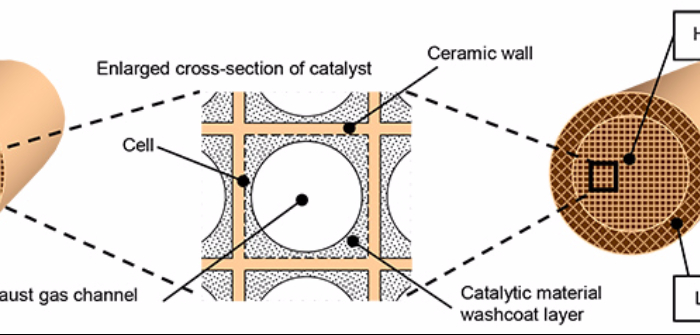Toyota Motor Corporation has announced the commercial availability of a new, smaller catalyst that uses 20% less precious metal in approximately 20% less volume, while maintaining the same exhaust gas purification performance. The design is the world’s first integrally-molded Flow Adjustable Design Cell (FLAD) substrate, with a different cell cross-sectional area at the inner portion compared to that at the outer portion. Innovative design and manufacturing technologies have allowed for the mass production of the new catalyst, which will gradually be installed in new vehicle models, starting from the Lexus LC500h later this year.
Increased usage of catalytic precious metals to clean exhaust gas and reduce air pollution presents many issues, including increased costs and resource depletion. Toyota has conducted extensive research and development into finding solutions to help improve the purification efficiency of catalytic precious metals, such as finding the optimal substrate shape and length, as well as modifying the cell wall thickness and cross-sectional area. Other R&D efforts include selectively washcoating precious metals and other catalytic materials, and changing catalytic substrate cell density in line with exhaust gas flows.
Toyota and Denso Corporation have developed this new FLAD® substrate to improve the uniformity of exhaust gas flow. Through a series of validations using simulations and prototype substrates, both companies have succeeded in improving uniformity of exhaust gas flow within the catalyst by optimizing factors such as the ratios of cross-sectional areas of cells at the inner and outer portions, and their corresponding densities. As such, with this development, approximately 20 percent less precious metal is used in a more compact catalyst that contains approximately 20 percent less volume, while maintaining the same exhaust gas purification performance as that of conventional catalysts. The newly developed innovative design and manufacturing technologies have also allowed for the mass production of the world’s first integrally molded catalyst.
Currently, the most commonly used substrate in exhaust gas purifying catalysts for gasoline engines is made of ceramic (cordierite), which utilizes a honeycomb structure consisting of square or hexagonal cells. The walls of cells within this substrate are washcoated with catalytic materials, like platinum (Pt), rhodium (Rh), palladium (Pd) and other precious metals. This provides a catalytic effect, where through oxidation-reduction, harmful gases such as carbon monoxide (CO), unburned hydrocarbons (HC), and nitrogen oxide (NOx) are purified within the exhaust to help make them safe.
While conventional catalysts have a uniform cell cross-sectional area, the newly developed FLAD substrate has a structure with a different cell cross-sectional area at the inner portion compared to that at the outer portion. Toyota has succeeded in mass producing this substrate with the world’s first design and manufacturing technology that is able to integrally mold the catalyst.
Uniform exhaust gas flow within the catalysts installed in exhaust pipes enables the washcoated precious metals and other catalytic materials to effectively purify the exhaust gas. However, the use of conventional substrates with uniform cell cross-sectional area results in an unbalanced flow of exhaust gas because the flow of gas through the inner portion of the catalyst is faster, and at a higher volume than that through the outer portion. As a result, more catalytic precious metal is required at the inner portion of the catalyst, where the flowrate is greater, in order to maintain purification performance. Current catalytic material washcoating technologies require all cell walls to be coated equally during the washcoating process, so parts of the catalyst with a lower exhaust gas flowrate are coated with the same amount of catalytic precious metals as those parts which have a higher flowrate.


